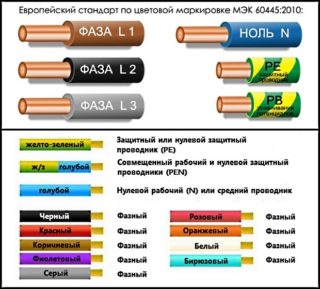Connecting a 2-way switch is necessary if you want to control two light sources from a single power point. An additional advantage is the ability to adjust the brightness and illumination of the luminaire in a classic and simple way. However, installation and adjustment requires certain knowledge and skills. In order not to be mistaken with the connection diagram, you need to familiarize yourself with the general points and recommendations of the wizards.
- Design and principle of operation of a two-button switch
- Safety engineering
- Preparing for installation
- Features of choosing a place for installation
- Preparing for installation
- Determination of wire parameters
- Identification of conductors with a multimeter
- Installing an electrical switch
- Wire connection options
- Connection diagram and procedure
- Installation of connections in the junction box
- Connection on a chandelier or lamp
- Connection errors
Design and principle of operation of a two-button switch
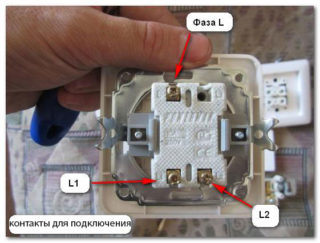
Switches and switches are simple in structure and few parts. The main elements are:
- buttons (up / down switching elements);
- case - external panel, removed before starting work;
- terminals - contacts that are connected to the wires of the electrical wiring.
The latter can be screw, clamping (depending on the design). The screw terminals are hinged or directly connected. These reliably hold the end of the cable, do not weaken or fail for a long time. The installer's recommendation is to check and tighten the terminals every six months.
Modern devices are supplemented with new details - backlighting, adapters, protection against voltage surges and others. These elements are optional and are intended to improve usability.
The connection of a light switch with two buttons is carried out by means of three wires - two parallel (usually connected from the top), one phase from the bottom. Some double devices consist of two separate switches under one housing, these are called modular (have more wires).
If multiple lamps need to be controlled by one device, stranded wires should be used. The two-button model allows you to work with these cables.
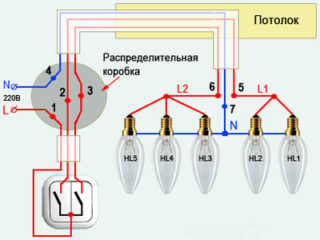
The principle of operation is as follows:
- turning on one key - glow of one lamp or group;
- when the second is connected, the illumination level changes (relevant for multi-lamp circuits);
- when turned on simultaneously - the light comes on at full power.
Dual-mode pushbutton switches save energy by reducing light when needed. The overall level of security of the premises also increases - mechanisms reduce the number of power points, which reduces the likelihood of short circuits and fires.
Safety engineering
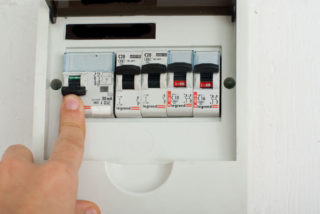
Working with electricity and networks is classified as the most dangerous. If the requirements are not met, you can get an electric shock - the consequences depend on the voltage level and individual characteristics (to a lesser extent). Basic rules (common to all types of actions with wires):
- de-energizing the site is the first and most important point;
- checking the wires for voltage - before direct connection, the cable is tested with special devices (ohmmeter and the like, you can assemble at home from scrap materials);
- use of additional protection - dielectric gloves, tools with rubberized handles, the like;
- study of instructions for devices, recommendations of masters;
- exclusion of any contact with water (for example, wet surfaces, puddles on the floor).
Failure to comply with the minimum set of safety requirements will lead to irreversible consequences (in some cases, fatal).
Preparing for installation
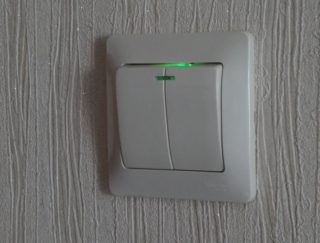
Standard devices today are complemented by backlighting and indicators. The first one allows you to find the switch in the dark, the second shows that the network is closed and working. Some models are supplemented with waterproof and resistant to mechanical damage cases. These can be installed in a bath, bathroom and other rooms with high humidity (including outside).
Another type is pass-through switches (another name is switches). The devices allow you to work with one group of luminaires at opposite ends of the premises. Actual use in long corridors, bedrooms.
Features of choosing a place for installation
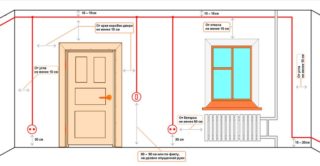
The legislation does not provide for specific requirements and strict restrictions. The requirements enshrined in GOST, TU and PUE (rules for electrical installations) are in most cases advisory in nature and relate to general safety, convenience and security. For example, the height is adjusted taking into account the average height of the users. The age of children and the possibility of their access to food outlets are also taken into account.
20-30 years ago, it was customary to install switches at a height of about two meters, today - at the level of the hand. In this case, the device becomes available to every user of the room.
Clear rules apply to rooms with high humidity and the presence of powerful electric heating devices. For example, the switch should not be located near an open shower or stove - in these cases, direct contact with water and excessive heating of the elements is possible.
Preparing for installation

It is not necessary to invite an electrician to connect a switch with two keys. The procedure is considered one of the simplest in an electrician, so you can connect the device to the electrical wiring yourself. First of all, you need:
- familiarize yourself with the safety requirements and take appropriate steps;
- understand the markings, markings on the wires and the case of the switch;
- check wiring and materials for compliance (voltage level, conductivity, size, others).
After that, the tools are collected. Standard set: knife for mounting, electrical tape, hammer, pliers, screwdrivers (indicator for checking the voltage in the network and curly). If the switch is internal and there is no corresponding socket, it will need to be drilled out or cut out (depending on the wall material).
Determination of wire parameters
Color coding:
- neutral wire - blue (always);
- protective - green with yellow (always);
- phase - red or brown (in most cases).
Manufacturers do not always follow these combinations. Therefore, it is important to learn how to "read" the marking in letters and numbers. If during the purchase it turns out that there are no symbols, you must consult with the seller, look at the packaging.After that, the wires are marked independently. For example, a multi-colored heat shrink tubing.
Identification of conductors with a multimeter
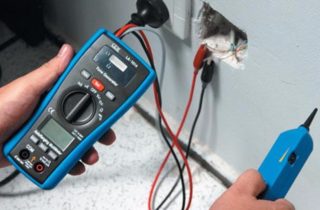
The need for additional verification is due to several factors. Firstly, the standards and designations of characteristics have changed quite often, so confusion can arise. Secondly, some manufacturers deliberately go for all sorts of tricks (to reduce production costs or increase the cost of a product).
Use a multimeter and a screwdriver for indication to ensure that the correct wires are selected. For single-phase networks, an indicator is suitable that will help determine the phase and neutral cables. After turning off the power, you must strip the ends (remove the insulating cover).
It is important that the stripped wires do not touch each other, otherwise, during the check, a short circuit or even fire will occur.
After that, the power is connected, one of the wires is touched with a screwdriver. If the light comes on, the cable is phase, otherwise it is zero. For networks that are grounded, you will need a multimeter. The voltage value is set (domestic in apartments - 220 Volts), one probe is connected to the phase, the second is brought to one of the remaining ones. Neutral will show a figure within 220 Volts, grounding - a lower value.
Installing an electrical switch
First, the keys and the external protective panel are removed. Use a thin knife (special or ordinary), carefully pry the first key, then the next, then the decorative cover. In some models, the parts are unscrewed. The internal mechanism is fastened to clamping or screw elements.
The last stage is to disconnect the conductors from the de-energized network, if necessary, dismantle the socket.
Wire connection options
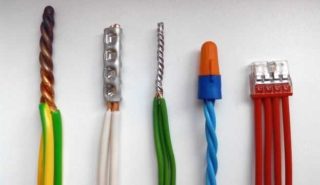
The places where the cables are connected together are the weakest in the chain. Most of the problems occur in such areas. Basic fastening methods:
- twisting by hand - used often, you need to additionally isolate;
- block with terminals - a mechanism that connects the wires;
- soldering is a rarely used method, special equipment and certain skills are required, the adhesion is reliable, but the laboriousness does not allow using the method often.
Heat shrink tubing helps insulate the connections and hold them together more.
Connection diagram and procedure
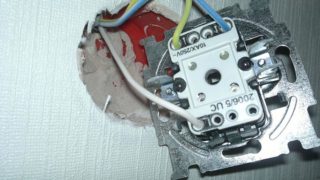
If electrical wiring is installed in the room, the connection diagram for the two-button switch turns out to be quite simple. A two-core cable is drawn from the main panel. The circuit is fixed with a transformer through which the neutral conductor is drawn. The main disadvantage is the low degree of security.
In the general case of the circuit breaker, one phase cable is connected to the main terminal (L), wound to the fasteners and fixed with screws or clamps. The rest are connected to separate microcontacts, then to the junction box and lamps. If there is more than one lighting fixture, the connection between them is carried out in series.
A phase cable is connected to the two-button switches from the shield. If you connect a zero instead, even a simple change of a light bulb becomes dangerous.
Installation of connections in the junction box
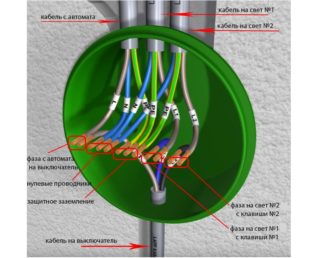
Certain wires are connected to the junction box or junction box: the power supply from the panel, the cable supplied to the switch, conductors to the lamps. To avoid mistakes, you must follow a certain sequence:
- zero - they do not put it into the switch, they are laid directly to the light bulbs;
- protective or grounding - not always available;
- phase.
The two circuits are connected separately from each other to obtain independent control.
Connection on a chandelier or lamp
With this connection, terminal elements are more often used. The wires are connected according to the color coding. Factory movements are color coded correctly. In this case, the ground wire can be fixed to the terminal or directly under the screw on the luminaire panel.
Connection errors
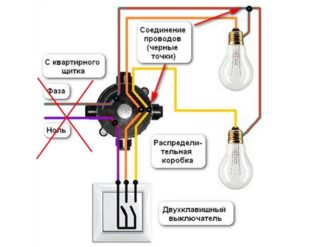
The most common problem for non-professional craftsmen is setting the breaker to zero, and not to phase. The device should break exactly the phase connection, there can be no other options. If you do the opposite, the voltage will constantly be on the chandelier or lamp. Therefore, it will be possible to get an electric shock even with the usual replacement of the light bulb.
An additional nuance is the glow of the indicator when checking the neutral wire. This is mainly due to the backlighting of the switch. A small amount of current in this case still passes through a special device thanks to the backlight contacts. This is the main reason for LED lights to flicker when off. It is necessary to turn off the additional backlight and the flickering will disappear.
Another serious mistake is the establishment of the power cable on the outgoing contact, and not on the main one. In this situation, the connection diagram of the two-key switch will be violated - the lamps will light up only when both keys are turned on simultaneously. The device must be disassembled, disconnected and connected correctly.
To connect a two-button switch, you must familiarize yourself with the general points and strictly observe safety requirements when working with electricity. Even a beginner can figure out the details. It is optional to invite a master. Before buying, you should decide on the network parameters.

